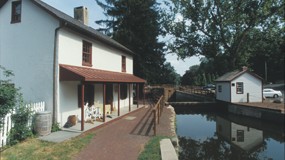The Delaware Canal – The Inn Place to Be
Bucks County is rich in history, and we can trace much of that history and growth to the impact of the Delaware River and Canal. River towns became hubs of industry, and when the Canal opened for operation, it spurred additional investment. Mills, lime kilns, farms, and other businesses flourished. When the Delaware Canal opened in 1832, it changed the river valley and the towns along the way. With improved transportation, commerce grew, and many people prospered.
As business people, travelers, and canallers flocked to the area, hotels and inns began to flourish. Many of the inns along the Delaware Canal were built around the same time. Others pre-date the Canal but certainly benefited from its operation. Trains and highways eventually replaced the Canal, however, many of the historic inns have remained, most for public use, while some are private homes. The number of Inns along the Delaware Canal makes this 58.9-mile waterway unique.
Starting in the north, we will take a walk back in time to revisit some of the inns and provisioners that have been around for centuries.
Riegelsville Inn
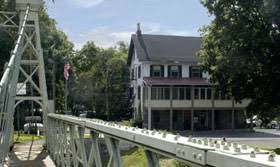 This Inn was built in 1838 by Benjamin Riegel, a wealthy miller who owned property on either side of the Delaware River. His New Jersey operations included a grist mill and an oil mill. John Riegel, the grandson of Benjamin, continued the industrial legacy of the family by adding a paper mill which became known as the Riegel Paper Company, one of the largest employers in the area until the 1990’s.
This Inn was built in 1838 by Benjamin Riegel, a wealthy miller who owned property on either side of the Delaware River. His New Jersey operations included a grist mill and an oil mill. John Riegel, the grandson of Benjamin, continued the industrial legacy of the family by adding a paper mill which became known as the Riegel Paper Company, one of the largest employers in the area until the 1990’s.
Riegelsville Inn is situated between the river and the Canal, next to the historic Roebling Bridge. It is listed on the Bucks County Register of Historic Places.
The original building is stucco over stone with porches facing the river and patio space on the Canal. At one point, the property also boasted a large barn with enough room for 50 horses (or mules).
Over the decades, the Inn has changed hands; however, it has remained in continuous operation for most of the past 160+ years. Today, the Inn offers fine dining throughout the week, with a brunch menu also available on the weekends.
The Narrows Inn (formerly the Indian Rock Inn)
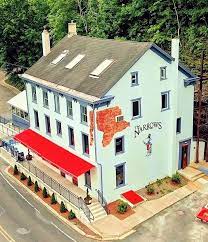 The Lenape Indian Tribe originally inhabited the site of the current Inn and restaurant. They used a deep natural pool in the rocks at the base of the Nockamixon Cliffs as a holding tank for fish they had caught in the Delaware River. When the current building was erected in 1820, owner Jacob Krouse used the rock walls of the tank as his new tavern’s foundation. The tavern license for the site dates back to 1812 when the pilots of lumber rafts were served a blicky (quart) of beer for a nickel.
The Lenape Indian Tribe originally inhabited the site of the current Inn and restaurant. They used a deep natural pool in the rocks at the base of the Nockamixon Cliffs as a holding tank for fish they had caught in the Delaware River. When the current building was erected in 1820, owner Jacob Krouse used the rock walls of the tank as his new tavern’s foundation. The tavern license for the site dates back to 1812 when the pilots of lumber rafts were served a blicky (quart) of beer for a nickel.
In 1837, new owner John Derr enlarged the business to accommodate weary travelers, and the Rising Sun Hotel came to be. It was known by that name until 1854, except for a short period in 1851 when owner Frederick Trauger thought it might do better as the Farmers and Traveler’s Inn. Apparently it didn’t, since the name and Trauger lasted less than a year. In 1854, owner Mathias Lehman changed it to the Narrowsville Hotel.
The Inn changed hands several times and was most recently called the Indian Rock Inn. This name derives from a nearby rock formation whose profile is said to resemble the face of an
Indian. The mural of an Indian life scene, painted in 1988 by Irish artist Eric Patton, decorated the north side of the building until the most recent renovation.
To the north of the Inn were mule stables, with a barn and blacksmith shop to the south.
Today, the Narrows Inn serves great food in alovely historic setting.
The Homestead General Store
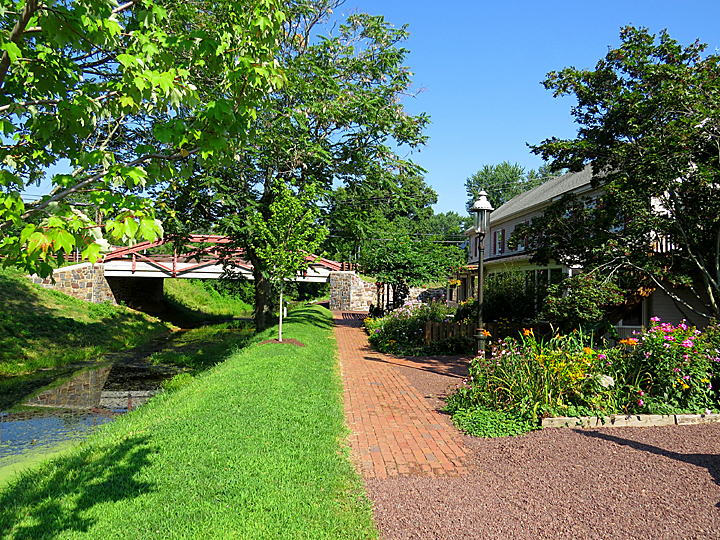 Another popular spot along the Canal is the Homestead General Store. This business has served the local community since the early 1800’s and is the oldest continuously operating general store in Bucks County providing provisions as well as a place to trade some canal gossip.
Another popular spot along the Canal is the Homestead General Store. This business has served the local community since the early 1800’s and is the oldest continuously operating general store in Bucks County providing provisions as well as a place to trade some canal gossip.
Originally built in 1831 by Hugh Major, the store arrived just in time to serve the newly opened canal and boatmen. Customers could stock up on provisions as well as local gossip. Today, the charm of the Homestead has been enhanced by the addition of a coffee roasting business. Their certified organic coffee is served and sold throughout Bucks and Hunterdon counties.
While the Homestead has seen several owners over the decades, Rick and Iris Lewis have been the proprietors since 1980. They have witnessed floods, bridge closures, and other calamities but have endured throughout it all. The Homestead has earned a reputation for its food and family-friendly atmosphere. It is a great place to stop along your towpath stroll.
Uhlerstown Hotel and Hamlet (formerly Uhlertown)
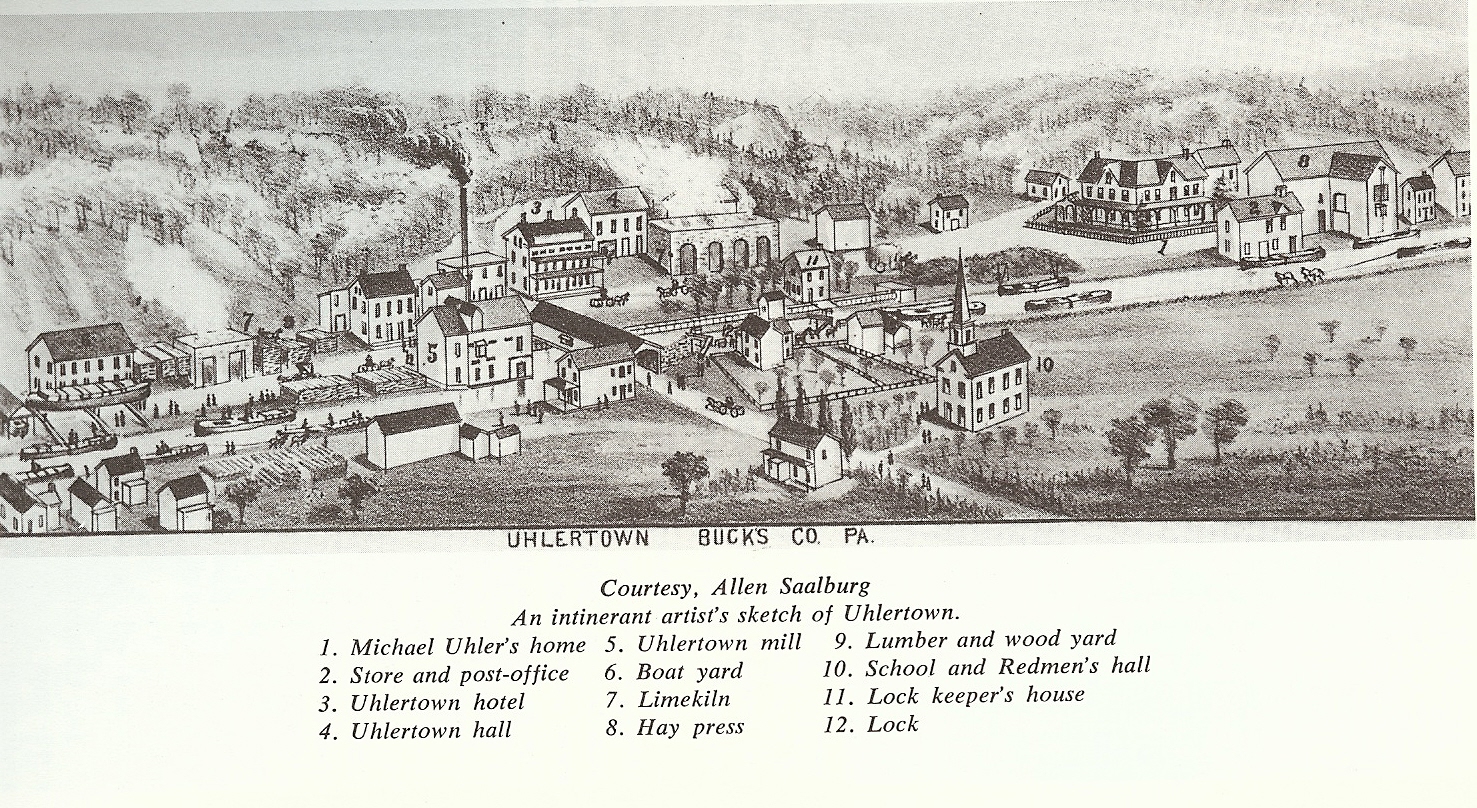 Now a private residence, the Uhlerstown Hotel was once a favorite resting spot for weary travelers. Built around 1840, the hotel was added to the National Register of Historic Places in 1994. Today, the entire hamlet is listed as a historic district.
Now a private residence, the Uhlerstown Hotel was once a favorite resting spot for weary travelers. Built around 1840, the hotel was added to the National Register of Historic Places in 1994. Today, the entire hamlet is listed as a historic district.
The natural charm of the hotel is enhanced by its location in this well-preserved little hamlet. Uhlerstown is one of the true historic gems along the towpath. This village was once a prosperous
settlement, built mainly around the Canal and its operations. Michael Uhler, a man of remarkable energy and business ability, recognized the opportunity that the Canal offered and moved downriver from the Groundhog Lock area between Riegelsville and Raubsville, where he and his brother Peter had been doing business.
Uhler developed the town that would be named after him. He is best known for operating a boat building yard and running a line of wellequipped canal boats called the Michael Uhler line. He owned extensive farmland from which grain and hay were supplied to the canal trade and metropolitan markets. He built and operated a gristmill and lime kilns, a country store and post office, a saddler shop, and coal yards. The hamlet is also home to the only covered bridge that spans the Canal.
Today, the historic district encompasses 63 contributing structures located along the Delaware Canal. Buildings of note include a brick building that once housed a school. The building to the right of the bridge entrance was the residence of Jonas Sigafoos who operated a general store. To the left of the bridge entrance, the present home was originally a warehouse for the gristmill located on the opposite bank of the Canal. Other historic buildings include the Uhlerstown Hall, a community gathering place for dances and entertainment, the Locktender’s House, and the remnants of lime kilns.
Golden Pheasant Inn
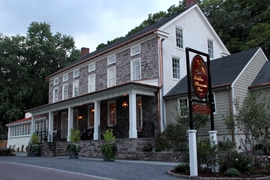 Originally called the Delaware House, the Golden Pheasant Inn was built in 1857 to cater to the canal trade. The Inn offered housing for men and mules along with provisions. When the Canal closed in 1931, the Inn suffered hard times until 1967, when it was purchased by Ralph Schneider, who named it the Golden Pheasant Inn.
Originally called the Delaware House, the Golden Pheasant Inn was built in 1857 to cater to the canal trade. The Inn offered housing for men and mules along with provisions. When the Canal closed in 1931, the Inn suffered hard times until 1967, when it was purchased by Ralph Schneider, who named it the Golden Pheasant Inn.
The Inn is situated on the eastern boundary of Tinicum township in a section of Bucks County which was called Manor of Highlands. In 1699, the 7,500 acres were purchased from William Penn
by the London Company.
In 1986, the Faure family purchased the property. Michel Faure was the chef, and his wife Barbara was the hostess and decorator. Barbara refurbished the rooms to the Inn’s original 1850s period
style. Within three months of opening, John Bull, a restaurant critic for the Philadelphia Inquirer, gave the new Inn a resounding “thumbs-up.”
The Faure’s daughters, Brittany, Blake, and Briar assumed the business and operated the Inn and restaurant for many years before selling it to the Thompson Hospitality organization.
Point Pleasant Inn (F.P. Kolbe’s)
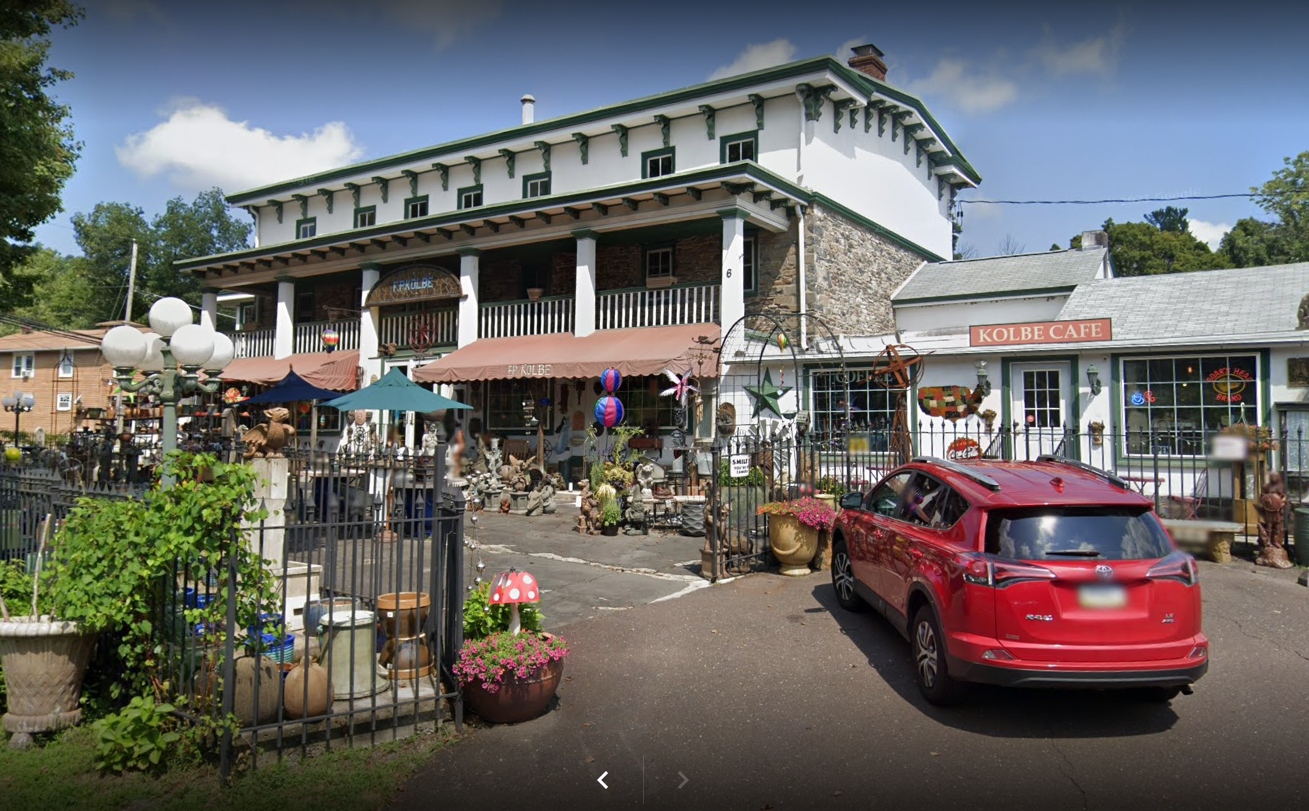 At one time, Point Pleasant was a bustling commercial center largely catering to the canal and carriage trade and then to vacationers who discovered the charms of this river valley town.
At one time, Point Pleasant was a bustling commercial center largely catering to the canal and carriage trade and then to vacationers who discovered the charms of this river valley town.
The Point Pleasant Inn (above, right), as it was initially known, was built in 1782. This grand hotel hosted Grover Cleveland, William McKinley, and other fishing enthusiasts. Prominent Astor, Whitney, and Vanderbilt family members were also guests. The elegant colonnaded façade faces out over what was once a lovely view of the Tohickon Creek.
Today, the building is home to F.P. Kolbe Gift Store & Café. It is a favorite shopping spot for seasonal decorative items, candles, garden fountains, and hand-crafted furniture.
Cuttalossa Inn (No longer in operation, but for sale)
Standing by the picturesque waterfall above the Cuttalossa Inn, it is hard to imagine that this was once the bustling center of the village of Lumberton. Approximately 200 people lived here, including Zebulon Pike (of Pike’s Peak fame) operating the quarries and several mills.
The Cuttalossa Inn was a general store and post office; the stone building across from it was “Hard Times Tavern” as the proprietor made barely enough to pay the rent.
The quarries above and below Cuttalossa Road produced stone used in mansions in Philadelphia and New York City. Canal barges transported it to Philadelphia and by railroad (Jersey side) to New York City. A cable car from the towpath across the river delivered the stone to the railroad.
A sawmill was located above the falls, powered by a 20-foot diameter water wheel; the mill race can be discerned on the left as one moves up Cuttalossa Road. Immediately below the falls, at the parking area level, was a decking from one bank to the other, called a forebay—a place to stack the milled lumber in an otherwise tight valley. This picturesque spot has been a favorite subject of painters and poets alike.
More Inns to Come
There are other notable historic inns, including the Black Bass Inn located in Lumberville. The Black Bass was built in 1740-1745, was partially destroyed by fire. There was substantial rebuilding in 1834. The original owner of the establishment was a Tory who favored the British, so George Washington did not sleep here. However, today all are welcome to eat or stay here.
The Washington Crossing Inn was built in 1817 and it features an original large kitchen hearth in one of its dining rooms. The Yardley Inn, once called the White Swan Inn was built in 1832.
And in Bristol, you will find one of George and Martha’s favorite spots, The King George II Inn (right). This Inn has a rich history, and is the oldest, if not one of the oldest, operating inns in the
country. Established in 1681, the property is lovingly maintained by the current owners who are committed to providing great food and service in a truly unique setting.
One last Inn we feel we should mention, was located in the village of Raubsville, north of Riegelsville and close to the Forks of the Delaware River. The building still stands today, but remains empty.
Take A Walk Back Inn Time
No matter where you start your hiking or biking excursion along the towpath, you are sure to pass one of these historic inns and businesses. We encourage you to take advantage of the views,
the food and the hospitality each has to offer.
